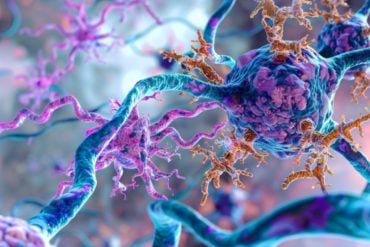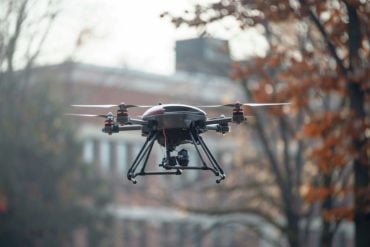Summary: CRISPR gene editing created the G795A amino acid which was introduced to microglia derived from human stem cells. Researchers were able to transplant the donor microglia immune cells into humanized rodent models while administering an FDA-approved cancer drug called pexidartinib. The inclusion of the amino acid cause the donated microglia to thrive and resist the drug, while the host microglia died. The findings open the door for new methods of using microglia to treat a range of neurodegenerative disorders.
Source: UC Irvine
Combating Alzheimer’s and other neurodegenerative diseases by inserting healthy new immune cells into the brain has taken a leap toward reality. Neuroscientists at the University of California, Irvine and the University of Pennsylvania have found a way to safely thwart the brain’s resistance to them, vaulting a key hurdle in the quest.
Their discovery about brain cells called microglia heralds myriad possibilities for treating and even preventing neurodegenerative disorders. The team’s paper appears in the Journal of Experimental Medicine.
When microglia are healthy, they serve as the central nervous system’s resident front-line disease warriors. “However, there is overwhelming evidence that they can become dysfunctional in many neurological conditions,” said Mathew Blurton-Jones, UCI professor of neurobiology & behavior and study co-lead author.
“Until recently, scientists have mainly been looking at the mechanisms that drive microglial dysfunction and trying to find drugs to change their activity. But with this study, we’ve found a way to potentially harness microglia themselves to treat those diseases.”
Frederick “Chris” Bennett, assistant professor of psychiatry at Penn and co-lead author, added: “There is an obstacle because once our own microglia develop in the location where they are supposed to be in our brains, they don’t give up that space. They block the ability to deliver new cells that would take their place. If you want to insert donor microglia, you have to deplete the host microglia to open up room.”
Bennett and his laboratory partnered with Blurton-Jones and his lab on the project.
Microglia depend on signaling by a protein on their surface called CSF1R for their survival. The FDA-approved cancer drug pexidartinib has been found to block that signaling, killing them. This process would seem to offer a way to clear space in the brain to insert healthy donor microglia.
However, there is a dilemma – unless the pexidartinib is stopped before the donor microglia are added, it will eliminate them, too. But once the drug is terminated, the host microglia regenerate too fast to effectively put in the donor cells.
This quandary has challenged efforts to treat people with certain rare and severe neurologic conditions. One is Krabbe disease, in which the body’s cells can’t digest certain fats that are highly abundant in the brain. Currently, clinicians use bone marrow transplantation and chemotherapy to try to introduce new immune cells similar to microglia into the brain. But this approach can be toxic and must be carried out before Krabbe symptoms manifest.
“Our team believed that if we could overcome the brain’s resistance to accepting new microglia, we could successfully transplant them into patients using a safer, more effective process in order to target a great number of diseases,” said co-first author Sonia Lombroso, a Penn Ph.D. student and member of the Bennett Lab. “We decided to investigate whether we could make the donor microglia resistant to the drug that eliminates their host counterparts.”

The researchers used CRISPR gene-editing technology to create one amino acid mutation, known as G795A, which they introduced into donor microglia produced from human stem cells or a mouse microglial cell line. Then they injected the donor microglia into humanized rodent models while administering pexidartinib, with exciting results.
“We discovered that this one small mutation caused the donor microglia to resist the drug and thrive, while the host microglia continued to die off,” said co-first author Jean Paul Chadarevian, a UCI Ph.D. student who is a member of the Blurton-Jones Lab. “This finding could lead to many options for developing new microglial-based treatments. Pexidartinib is already approved for clinical use and appears to be relatively well tolerated by patients.”
Approaches could range from fighting disease by replacing dysfunctional microglia with healthy ones to designing microglia that can recognize imminent threats and strike against them with therapeutic proteins before they cause harm.
The UCI-Penn team believes treatments based on this kind of microglial method could be developed within a decade. Their next investigations include studying in rodent models how to use the approach to attack the brain plaques associated with Alzheimer’s and to counter Krabbe and other similar diseases.
Funding: Support for the project was provided by the National Institutes of Health, National Science Foundation, The Paul Allen Frontiers Group, Klingenstein-Simons Fellowship Award in Neuroscience and the Susan Scott Foundation.
About this neuroscience research news
Author: Ethan Perez
Source: UC Irvine
Contact: Ethan Perez – UC Irvine
Image: The image is in the public domain
Original Research: Closed access.
“Engineering an inhibitor-resistant human CSF1R variant for microglia replacement” by Mathew Blurton-Jones et al. Journal of Experimental Medicine
Abstract
Engineering an inhibitor-resistant human CSF1R variant for microglia replacement
Hematopoietic stem cell transplantation (HSCT) can replace endogenous microglia with circulation-derived macrophages but has high mortality. To mitigate the risks of HSCT and expand the potential for microglia replacement, we engineered an inhibitor-resistant CSF1R that enables robust microglia replacement.
A glycine to alanine substitution at position 795 of human CSF1R (G795A) confers resistance to multiple CSF1R inhibitors, including PLX3397 and PLX5622. Biochemical and cell-based assays show no discernable gain or loss of function. G795A- but not wildtype-CSF1R expressing macrophages efficiently engraft the brain of PLX3397-treated mice and persist after cessation of inhibitor treatment.
To gauge translational potential, we CRISPR engineered human-induced pluripotent stem cell–derived microglia (iMG) to express G795A. Xenotransplantation studies demonstrate that G795A-iMG exhibit nearly identical gene expression to wildtype iMG, respond to inflammatory stimuli, and progressively expand in the presence of PLX3397, replacing endogenous microglia to fully occupy the brain.
In sum, we engineered a human CSF1R variant that enables nontoxic, cell type, and tissue-specific replacement of microglia.






